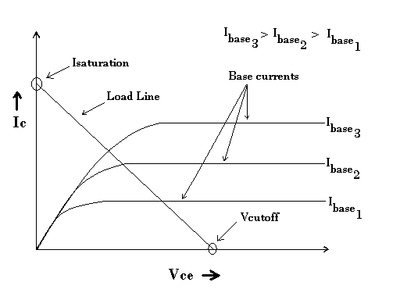
Load line (electronics)
Encyclopedia

Electronic circuit
An electronic circuit is composed of individual electronic components, such as resistors, transistors, capacitors, inductors and diodes, connected by conductive wires or traces through which electric current can flow...
, representing the constraint other parts of the circuit place on a non-linear
Nonlinear device
In an electric circuit, a nonlinear element or nonlinear device is an electrical element which does not have a linear relationship between current and voltage. A diode is a simple example...
device, like a diode
Diode
In electronics, a diode is a type of two-terminal electronic component with a nonlinear current–voltage characteristic. A semiconductor diode, the most common type today, is a crystalline piece of semiconductor material connected to two electrical terminals...
or transistor
Transistor
A transistor is a semiconductor device used to amplify and switch electronic signals and power. It is composed of a semiconductor material with at least three terminals for connection to an external circuit. A voltage or current applied to one pair of the transistor's terminals changes the current...
. A load line represents the response of a linear circuit connected to the nonlinear device in question. The operating point is where the parameters of the nonlinear device and the parameters of the linear circuit match, according to how they are connected while still adhering to their internal systems.
In the example on the right, the nonlinear diode is placed in series with a linear circuit consisting of a resistor
Resistor
A linear resistor is a linear, passive two-terminal electrical component that implements electrical resistance as a circuit element.The current through a resistor is in direct proportion to the voltage across the resistor's terminals. Thus, the ratio of the voltage applied across a resistor's...
and a voltage
Voltage
Voltage, otherwise known as electrical potential difference or electric tension is the difference in electric potential between two points — or the difference in electric potential energy per unit charge between two points...
source. The load line represents the relationship between current
Electric current
Electric current is a flow of electric charge through a medium.This charge is typically carried by moving electrons in a conductor such as wire...
and voltage in the linear part of the circuit while the exponential represents the relationship between current and voltage in the nonlinear device. Since the current going through three elements in series should be the same, the operating point of the circuit will be at the intersection of the exponential with the load line.
In a BJT
Bipolar junction transistor
|- align = "center"| || PNP|- align = "center"| || NPNA bipolar transistor is a three-terminal electronic device constructed of doped semiconductor material and may be used in amplifying or switching applications. Bipolar transistors are so named because their operation involves both electrons...
circuit, the BJT has a different current-voltage (IC-VCE) characteristic depending on the base current. Placing a series of these curves on the graph shows how the base current will affect the operating point of the circuit.
The load line can be used for both dc and ac analysis. Once a dc operating point is defined by the dc load line an ac load line with, in general, a different slope intersects the dc operating point. In reality there are many ac load lines that vary from the dc load line to a limiting load line all having a common intersection at the dc operating point. This limiting load line is generally referred to as the ac load line and is the load line of the ac circuit (capacitors shorted, dc sources opened, etc...).
Common-Emitter
The given load line diagram is for the Common emitterCommon emitter
In electronics, a common-emitter amplifier is one of three basic single-stage bipolar-junction-transistor amplifier topologies, typically used as a voltage amplifier...
configuration.

The point on the load line where it intersects the collector current axis is referred to as saturation point. At this point, the transistor current is maximum and voltage across collector is minimum, for a given load. For this circuit, IC-SAT= VCC/RC.
The cutoff point is the point where the load line intersects with the collector voltage axis. Here the transistor current is minimum (approximately zero) and emitter is grounded. Hence VCE-CUTOFF=Vcc.
The operating point of the circuit in this configuration is generally designed to be in the active region, approximately between middle of the load line and close to saturation point. In this region, the collector current is proportional to the base current, and hence useful for amplifier
Amplifier
Generally, an amplifier or simply amp, is a device for increasing the power of a signal.In popular use, the term usually describes an electronic amplifier, in which the input "signal" is usually a voltage or a current. In audio applications, amplifiers drive the loudspeakers used in PA systems to...
applications.

